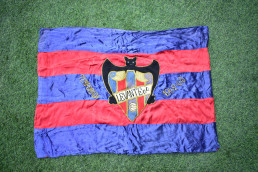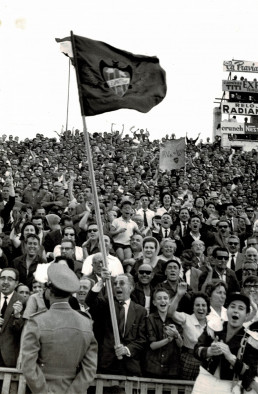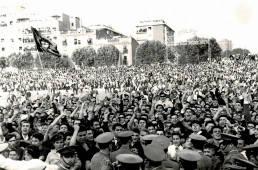In the early sixties, Daniel Pérez Marco was a man of deep convictions. He was an experienced and seasoned fan. And he displayed an unbridled optimism with contagious effects. At this point in history, we could see that he was a man with a sentimental attachment to Levante and an optimist by nature. In the blaugrana imaginary, these two assumptions are sometimes refractory, but in this particular case they are fundamental ideas that allow us to define his conception as a sympathiser of the azulgrana cause. In the early sixties, there were no suspicions about his long-standing militancy. Time vouched for this close and deep understanding. Pérez Marco grew up and matured as a gymnast. After the Civil War he suffered in his own flesh the process of reconversion that provoked the birth of the UDLG and the definitive transformation into Levante UD in June 1941. He never abjured his faith. It was an unbreakable rule. Gimnástico, UDLG and Levante UD were consubstantial elements in his life.
There was no doubt about the optimism that always characterised him. The intrahistory that hides this flag that waved to the rhythm of the goals scored by Serafín and Vall in Vallejo’s stadium on a magical afternoon becomes a paradigm. His grandson Daniel Pérez Sáez steps forward to wrap the past with the present in order to confirm this thesis. “When the famous year of promotion arrives, I don’t know what my grandfather’s feeling would be, but what is certain is that he made this flag long before the promotion was achieved in June 1963. His sons, that is, my father and my uncle, confirm that he embroidered the flag long before promotion became a reality. I thought that this flag was after promotion, but it was not. Since the middle of that season, my grandfather had been going to Vallejo’s games with that flag. He had prepared it beforehand because he was surely confident of promotion. My grandfather had longed for promotion all his life. For him it must have been total ecstasy,” he testifies with undisguised pride.
We do not know with certainty the cause that guided this action. Perhaps Daniel Pérez Marco had a fascinating vision on one of those trips he used to make from Godella station to the Vallejo pitch on the now defunct train that connected with the Pont de Fusta station on football days. Perhaps the years of affiliation to the azulgrana cause allowed him to perceive future events with meridian clarity. Or perhaps he shared that dream of the long-awaited promotion with his co-religionists in the improvised get-togethers that were organised in the vicinity of Vallejo in the run-up to the league matches. Possibly that team of committed footballers smelled like an epic. And one of the great ones, especially after taking off in the second round of the competition. The truth is that Daniel Pérez acted diligently as he did when dealing with any operation related to Levante. “He went to the Plaza de la Merced and I can’t say which shop it was, but he ordered the flag with the embroidery indicating the 1962-1963 season”.
Our protagonist did not know how far-reaching his decision would be. He was making a pact with the calendar to perpetuate himself through a legendary date in the history of the Granadan institution. This is not an exaggerated statement. There is a truly iconic image linked to the legendary promotion to the Primera Division that shows a Granota fan with a proud face waving a flag in the blue and blue colours.
We can recognise Daniel Pérez waving the flag in the wind.
The euphoria and passion he conveys is obvious. Levante had made it through to the top flight after beating Deportivo La Coruña in the decisive promotion match (2-1). Daniel Pérez Marco is an immensely happy man. The photo is the epitome of extreme happiness. You only have to look at the expression on his face to recognise this state of mind characterised by happiness and hope. The snapshot allows us to recognise Vallejo’s background, which served as a place for the old marker of the installation in Alboraya street. Daniel Pérez Marco transpires and transmits Levantinism on a mythical day.
There is another image that is representative of that sporting milestone. It happened at the end of the match when the fans stormed the Vallejo pitch to celebrate their heroes. Once again, the flag becomes relevant. In this case, it is difficult not to fix one’s attention on this emblem. It seems to reach the Vallejo sky above the heads of the Blaugrana fans. One of the most striking aspects is the enormous size of the flagpole. “I think he wanted to make the flag bigger,” his grandson says with a smile. The question is immediate: why was it so slender and towering over the rest? There is a mundane explanation that clears up this sort of enigma. The key lies in a mast that seemed to challenge the firmament. “He was able to get such long poles because of his profession as a baker. They had 2.5, 3.5 and even 4 metre poles for baking bread. It was very easy for him because he had those sticks. I think he wanted to show his love for the Levante in the biggest way. If he needed a four-metre pole, he would take a four-metre pole. Whatever it took for his Levante”.
Perhaps in an unsuspected way it acquired eternity. These images illustrate that legendary ascent. It is recurrent to return to them to remember and immortalise that historic event. “For us it is a source of pride that my grandfather appears in most of the Levante stories”. In fact, in the exhibition commemorating the 110th anniversary, he is part of the photo album. Holding that flag, Daniel Pérez enjoyed the experience that it meant for the club to break into the top flight. In that sense, he extracted the marrow out of that short stay in the elite. Football is a good excuse to get to know every corner of the Iberian Peninsula. “In Levante’s first year in the First Division, my grandfather travelled to the Bernabéu, to the old San Mamés, to the Metropolitano… He travelled all over Spain with Levante. He used to tell me about the welcome he received back then. Nothing to do with what happens now. You showed up with a rival flag and they invited you to eat, they showed you around the pitch, they treated you very well. It was a very different atmosphere. There are some hilarious anecdotes. “He told me he went to Barcelona and his car broke down on the way. He had to hitchhike to get to Barcelona, but he went and saw Levante. That flag always went with him when he travelled. It was a way to go sightseeing in Spain if you liked football”. His grandson is clear. “This flag symbolises Levante’s happiest time in the Primera División”.
And at this point, how was this identity forged? What was the process that marked his condition as a Levantinista? We have to travel to Valencia at the beginning of the 20th century. Daniel Pérez was born in 1910 in the Carmen neighbourhood. Football, a new discipline which came from England and which had been introduced in the city through the Port, was beginning to spread throughout the city. In this area of action, the heart of El Carme, the influence of Father Basté’s Patronat de la Jeunesse Ouvrière on the youngsters is an amalgam. “My grandfather started playing a sport that was becoming popular in many parts of Valencia. He told me that they started playing on the river, on a field that was under the Civil Government. He remembers playing in a team called Patronato-Gimnástico. My grandfather became very fond of football from then on”.
The flame remained unalterable and was perpetuated through Gimnástico. That team, linked since 1909 to the world of the Patronato de la Juventud Obrera, grew after leaving this institution in 1915 to become a classic of Valencian football in the twenties and thirties. Its social mass is inextricably linked to the Barrio del Carmen. “My grandfather stopped playing football, because he was heading towards his professional life, and joined Gimnástico. He became a Gimnástico fan. He used to tell me about the glorious times of the regional championships. He knew all the pre-Liga titles that Gimnástico had won. He told me about the rivalry with Valencia, Levante or Cabañal”, his grandson recreates with emphasis. And he continues: “Later the Liga was created and then came the story we all know after the Civil War with the creation of the famous UDLG which ended up becoming Levante. My grandfather boasted of having been a UDLG player and continued to go to Vallejo to watch Levante”, he adds, summarising a relevant passage in the football history of the city of Valencia.
The forties and fifties mark their alliance with the club born from the merger of Levante and Gimnástico. Nothing seems to have changed, despite the complicated agreement between two clubs with antagonistic ideological and social positions. He was a man of deep beliefs in soccer. “For him it was a sacred rite to go to Vallejo’s field every Sunday at five o’clock in the afternoon. He usually went with time and was part of the get-togethers that were set up before the games. My grandfather didn’t go to bars, nor did he belong to any supporters’ club,” says his successor. Daniel Pérez was a generous supporter. He spared no effort if he had to help out. “I know that there were seasons when members made financial contributions. My grandfather was one of those who put everything he was able to distract my grandmother for the benefit of Levante. That was his passion. And he points out. “I remember conversations between my grandfather and my grandmother in which my grandmother told us that the world could collapse or there could be a flood, but my grandfather would never miss a Levante game. That’s how it was.
And so it was until the end of time. Daniel lived the transfer that implied the wired passage of the old Vallejo in the direction of the Nou Estadi. It would be logical to assume that the flag would make that transit. They were flesh and blood; Lennon and McCartney. And it is not unreasonable to think that it would spread its wings again to coincide with one of the returns from the Third Division to the Second Division or from the Second B to the Silver category. “I don’t remember, but I imagine that on some special occasion, coinciding with a promotion, I would take it out, but I don’t remember clearly. When I was 11 or 12 years old I stopped coming to the stadium with him because he started to lose his sight. At the beginning he still came to the stadium, but little by little he stopped coming to the games”.
And what happened to the flag? At present the flag of the ’63 promotion is guarded by Daniel Pérez Sáez. “There is a moment when the flag is put away. The eldest grandson inherits it and it is my turn. Traditionalism prevailed at that time, but I am the one in the family who has inherited the love for Levante that my grandfather passed on to me”. The surveillance is close. It is a vestige of a past that binds him to his grandfather. “I’ve never brought her to soccer to cheer because I don’t want to risk anything happening to her. It’s something of mine from my family. It’s from us. I keep it like gold. He kept it like an heirloom,” says Daniel Pérez Sáez.
An emotional legacy. Daniel Pérez Marco had vision problems and stopped playing soccer on Sundays, but he never lost his enthusiasm, nor that contagious optimism to reedit the sensations he felt after the promotion in 1963. “Back then (in the 1980s) Logroñés was in the First Division and I told myself that Levante had to be a team like Logroñés, which year in and year out was in the First Division and one year would qualify for UEFA”. His predictions came true. “You saw Levante in UEFA with JIM and before that I enjoyed the 2004 promotion. I couldn’t get my grandfather out of my head. Also, we went to the party that was in the Malvarrosa and then we went to the Carmen to celebrate. We would go into the pubs and they would play the Levante anthem. I was really excited. The 2004 promotion was magical. My grandfather’s passion was born in El Carmen and I was celebrating the fact that we had been promoted to the First Division, where everything was born”.


